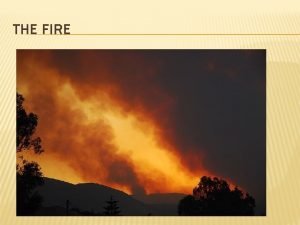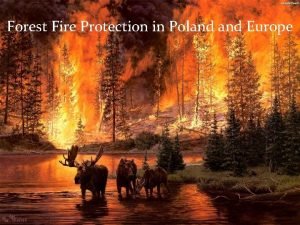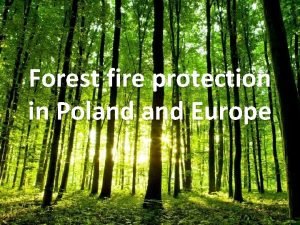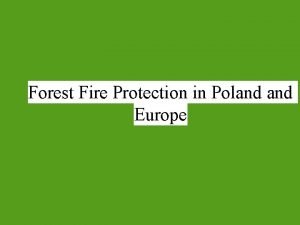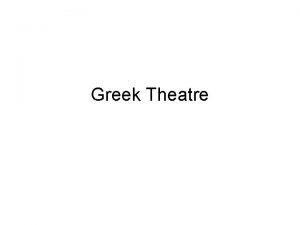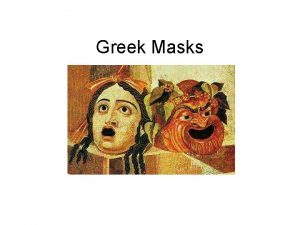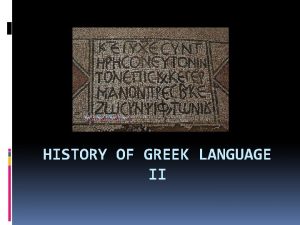THE FIRE THE FIRE The 2007 Greek forest




















- Slides: 20

THE FIRE


THE FIRE � The 2007 Greek forest fires were a series of massive forest fires that broke out in several areas across Greece throughout the summer of 2007. The most destructive and lethal infernos broke out on 23 August, expanded rapidly and raged out of control until 27 August, until they were put out in early September. The fires mainly affected western and southern Peloponnese as well as southern Euboea. The death toll in August alone stood at 67 people. In total 84 people lost their lives because of the fires, including several fire fighters.

Some of these firestorms are believed to be the result of arson while others were indeed the result of mere negligence. Hot temperatures, that included three consecutive heat waves of over 40 °C (105 °F), and severe drought rendered the 2007 summer unprecedented in modern Greek history. From the end of June to early September, over 3, 000 forest fires were recorded across the nation. Nine more people were killed in blazes in June and July.

� A total of 2, 700 square kilometers (670, 000 acres) of forest, olive groves and farmland were destroyed in the fires, which was the worst fire season on record in the past 50 years. Of the total of 2, 700 km², 1, 500 km² (370, 000 acres) were burnt forests in Southern Greece alone. Many buildings were also destroyed in the blaze. The fire destroyed 1, 000 houses and 1, 100 other buildings, and damaging hundreds more.

JUNE � The first major fire of the summer of 2007 was started on 28 June 2007. It is perceived to have been started by either an exploding electrical pylon or by arsonists. Significant parts of the Parnitha National Park were destroyed, and in total, the fire burnt 15, 723 acres (63. 6 km 2)of the core of the national forest in a matter of days. Overall the mountain of Parnitha suffered a burnt area of 38, 000 acres (153. 8 km 2), making it one of the worst recorded wildfires in Attica since the Penteli fire of July 1995.

� The magnitude of the devastation was unforeseen. Environmental studies in Greece report that the Athenian microclimate will significantly change to warmer during the summer season, and flooding is now a very probable danger for the northern suburbs of the city. Mount Parnitha was considered the lungs of Athens; following its considerable burning, both the city and local flora and fauna are expected to feel the consequences. Other affected areas included Pelion, Agiaand Melivoia, Skourta, Dafni, and Pyli.

JULY � � On 11 July 2007 sparked at a garbage dump near Agia Paraskevi, Skiathokos, and spread across the island. Residents and tourists were forced to evacuate to nearby Troulos, and returned after the fire was put out. More than 100 fires were reported by 15 July 2007, in such locations as Keratea outside of Athens, Peloponnese, and on the Aegean islands of Andros, Evia, Lesbos, and Samos, as well as Crete and the Ionian island of Kefalonia. In Peloponnese around 20 July 2007, a fire which started from the mountains over the town of Aigio expanded rapidly towards Diakopto and Akrata, destroyed a large area of forests and cultivated land. In the same fire many villages were totally or partiallly burned, resulting in the loss of 230 houses and 10 churches; three people lost their lives. A 26 -year old farmer and a 77 -year old woman were arrested on suspicion of arson concerning the fires in Aigio and Diakopto. The farmer confessed and is currently held in prison.

AUGUST � Fires continued, on 17 August 2007 they started to burn on the outskirts of Athens. The fire started from Mt. Penteli and started burning down towards the suburbs. More than sixty fire engines, nineteen planes and helicopters, and hundreds of firefighters as well as locals attempted to hold back the fire. Melisia, Vrilisia, and Penteli city were affected in the blaze that was put out, once winds calmed down.

� On 24 August 2007, fires broke out in Peloponnese, Attica and Euboea. In Peloponnese, the fire burnt many villages and accounted for 60 deaths. Six people were reported to have been killed in the town of Areopoli. In Zacharo, one of the worst hit areas, at least 30 people were found dead by firefighters while searching burning cars and homes. � Prime Minister Kostas Karamanlis declared a state of emergency for the whole country and requested help from fellow members of the European Union. Multiple countries responded to the call and sent help. Additionally, 500 Greek soldiers were sent in the affected areas. Another 500 Greek soldiers were called up bringing the total to 1, 000 military personnel involved in the fire fighting. On 25 August 2007, fires broke out on Mount Hymettus and in the suburb of Filothei in Athens. Officials said these fires were the result of arson, as the firefighters found many bottles with gasoline in affected areas. Arson is also suspected for the fires in Peloponnese, as more than 20 fires started at about the same time. Two fires broke out in Keratea and one in Markopoulo Mesogaias in East Attica on 25 August 2007. The first fire was not under control until the following day, while the second was put out quickly. The Keratea fire had a length of 12 kilometres (7 mi) and a man was hospitalised with second degree burns. The fire at Lagonissi was reported as an accident, when a man �

OLYMPIA � Olympia, site of the ancient Olympics and World Heritage Site, was evacuated on 26 August 2007. [19] Fears were expressed for the survival of the ruins of ancient Olympia lying near the raging fire. The famous statue of Hermes of Praxiteles and nearby antiquities were spared from the fire, but the yard of the museum where the statue is housed was scorched. [23][2 According to the official statement of former Minister of Culture Georgios Voulgarakis, no serious damage was caused to the antiquities. The fire burnt all the trees on the hilltop above, and an area of brush and open space adjacent to the Olympic Academy. The fire did not damage the archaeological museum nor did it damage the several ancient structures in the area. "The wider archaeological space of Olympia remains intact, " stated Mr. Voulgarakis. Despite the Minister's claims, it has been established, as of 26 August, that the afflicted damage is of greater importance and scale; the sacred Hill of Kronos was totally burnt during the blaze. The hill was left blackened, but will soon be reforested. New Culture Minister Michalis Liapis has stated that 3, 200 bushes and saplings will be planted on the Hill of Kronos, to return the area to its previous appearance.

SEPTEMBER � The fires continued to burn into early September. On 1 September 2007, firefighters were still suppressing a strong blaze in Peloponnese. Three blazes remained, with the fires destructive path continuing in Arcadia and Mt. Parnon in Laconia. Then, on 3 September 2007 a lightning strike started a new fire on Mt. Vermion, which was soon brought under control by firefighters. On 5 September the death toll reached 67, and on 21 September reached 68.

FIRES PHOTOS







 2007 greek forest fires
2007 greek forest fires Delhi fire service act 2007
Delhi fire service act 2007 Persuasive devices
Persuasive devices Fire in forest
Fire in forest Deforestation
Deforestation The greek miracle
The greek miracle Greek fire definition ap world history
Greek fire definition ap world history Damper interface panel
Damper interface panel Uttar pradesh fire prevention & fire safety rules, 2005
Uttar pradesh fire prevention & fire safety rules, 2005 Rwi are
Rwi are Reichstag fire who was the fire starter
Reichstag fire who was the fire starter Fire extinguisher parts
Fire extinguisher parts Trời xanh đây là của chúng ta thể thơ
Trời xanh đây là của chúng ta thể thơ Voi kéo gỗ như thế nào
Voi kéo gỗ như thế nào Các số nguyên tố
Các số nguyên tố Thiếu nhi thế giới liên hoan
Thiếu nhi thế giới liên hoan Vẽ hình chiếu vuông góc của vật thể sau
Vẽ hình chiếu vuông góc của vật thể sau Các châu lục và đại dương trên thế giới
Các châu lục và đại dương trên thế giới Một số thể thơ truyền thống
Một số thể thơ truyền thống Thế nào là hệ số cao nhất
Thế nào là hệ số cao nhất Hệ hô hấp
Hệ hô hấp
